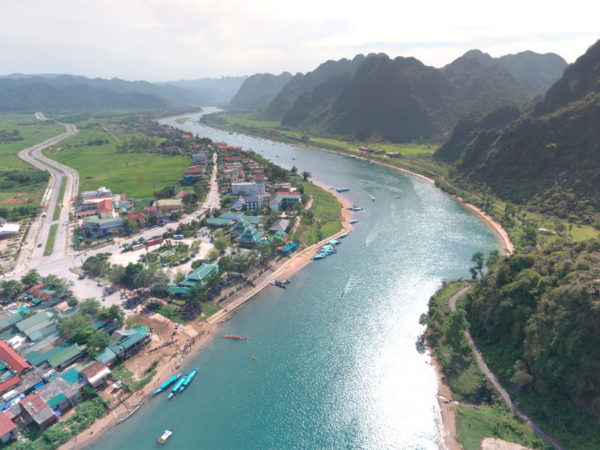The diversity of topography – geomorphology is determined by geological structure and petrographic composition which are also the reasons for forming the network of hydrology, groundwater, climate – environmental landscape, natural geography and biodiversity in a vast land of mysterious wilderness. Phong Nha – Ke Bang is a land in Quang Binh province gathering natural diversities which are bondly combined in close natural relations and blended together like a harmoniously enclosed energy cycle, and it is so perfect that it may be seen as the whole system without being seperated any individual. Many signs of geological tectonics are found here that demonstrate a vibrant development of the crustal of earth over the past 410 million years, from the Devonian Era to the present. That complicated tectonic history is the cause of all causes that make and break, and is the spiral evolution which determines geological and geomorphological faces like today.
Books about history and geography under the Nguyen Dynasty mentioned the mountainous area of Phong Nha – Ke Bang, particularly it was written about Quang Binh province with Phong Gia Mountain in the book “Dai Nam Nhat Thong Chi”, the National History in the Nguyen Dynasty: “Only 40 miles from northwest of Bo Chinh district, there are craggy cliffs which is adjacent to a big river in the North and Tien Coc mountain (Tien Cave) in the West”. It is also mentioned in the book that there is Thay Tien cave, also called as Nui Thay cave with “its back is steep as a wall, dark and deep; the stalactites hang down in the caves like a flower tree, some look like chains of pearls, others look like a Buddha statue, or like a brocade, it is a serene landscape indeed.
Phong Nha – Ke Bang covers a vast mountainous area which is like a panoramic picture of rivers and animals living together very vividly. Moreover, this cave system is so majestic that many cavernologists in the world admire and estimate that there are about 300 large and small caves, but only a small scale of the whole system has been discovered.
Perhaps Léopold Michel Cadière, a French missionary who came to Vietnam and was assigned to take pastoral care of a church in Phong Nha in the early years of twentieth century was considered as the first person to bring the caves at Phong Nha Ke Bang to the outside world. Phong Nha cave was named as “The No.1 Cave in Indochina” by the priest after exploring caves, discovering Cham scripts. And recently, intensive research has been made by the world famous geologists from the Royal Cave Association of England in a methodical and scientific way, so that Phong Nha Ke Bang is known widely around the world. Phong Nha – Ke Bang National Park was not recognized as a world natural heritage until 2003 by UNESCO, which not only preserves the integrity of geology and geomorphology but also hides many natural mysteries in it. The caves in the limestone mountains were naturally formed millions of years ago. With many complex cave systems hanging on the cliffs of the mountains or being hidden in the underground river, there are best known caves that visitors should not miss when visiting Quang Binh.

- Thien Duong cave: the longest dry cave in Asia with a total length of 31.4 km, a width of 30-150m and a height of about 60-80m, and the special structure of magnificent and fanciful stalactite makes people think of a heavenly place on earth. The cave floor is quite flat with flexible soil so the sightseeing and exploration are easy and in order to protect the nature factor, tourists have to walk on a 1.1km long wooden road to watch the beautiful stalactites in the cave after a climb of over 500 steps hidden under the primeval forest. The inside temperature is always about 20-21°C in summer while the outside one is up to 36-37°C.
2. Tien Son cave or Dry cave: a famous beautiful one in Phong Nha-Ke Bang with a length of 980m which is about 1,000m from Phong Nha cave’s entrance and 200m above the sea level. Although Phong Nha and Tien Son caves are adjacent to each other, there is no connection between these two caves. With thousands of stalactites hidden in many illusory colors, the marble columns have splendid shapes that make visitors ecstatic as if they were lost in a place of a fairyland, so that it was named as Tien (Heaven) cave by locals. It was formed tens of millions of years ago, when a stream of water flowed through the hollowed mountain and eroded the limestone mountain. Then, due to geological tectonics, this massif was either raised, or lowered, causing the rock blocks to collapse, blocking the flow, creating Tien Son cave at the top, while the part in the underground river flowing through formed Phong Nha cave.
3. Son Doong Cave: was formed between 2 – 5 million years ago, when river water flowed into the buried limestone area along a fault line, the water flow eroded and formed a giant tunnel in the ground, while other places with soft rocks, the ceiling collapses to form sinkholes and after a very long time it turns into giant cave arches. Its location is found deeply in the core area of Phong Nha – Ke Bang National Park, Son Doong is considered as the largest natural cave in the world, and a very interesting destination of exploring and experiencing for those who are in good health and have passion for discovering wilderness. The cave is more than 8.5 km long with its dome at an altitude of 200m above sea level, in some places it reaches 250 m, the volume of the cave is estimated at 38.5 million cubic meters.

3. Tu Lan Cave: passing through big valleys, green grasslands, and dense tropical forests, and then visitors have to swim into cool underground rivers which bend around mountains and valleys. Furthermore they have to climb the slopes of the mountain and cross the hills. Its richness and magical diversity make visitors extremely amazed, and they can also watch butterflies while sleeping in hammocks under the starry sky … those are unique experiences when visiting Tu Lan cave. Its beauty is so unique and wild that Tu Lan cave was chosen as the filming site for the movie Skull Island by the famous director Jordan Vogt Roberts.
- En cave: in a total length of 1,645m getting through a mountain and deeply located in Phong Nha – Ke Bang National Park which has a pristine beauty of primeval forests in Vietnam. Hang En is the third largest cave in the world which runs next to Son Doong cave and Deer cave in Malaysia that is unique with its mixed colors of the green river and the light shining from atriums. When the sunlight shines on the ceiling of the cave it makes the scene more shimmering and fanciful. It is named Hang En due to many swallows living here all year round which are not migratory birds.
- Dark Cave: experiencing fascinating activities such as exploring caves in the dark with a flashlight mounted on the heads, mud bathing, swimming in a dark lake, kayaking, and skiing on the zipline are only found at Dark Cave and Chay River. With dense darkness covering every corner of the cave in a length of 5,258m, it is called Dark Cave and seen as a “Small Son Doong”. Especially when water level rises in the rainy season, the accumulation of young mud layers will take place which forms a large mud lake with enough amounts of essential minerals for visitors to relax and take a mud bath.
- Phong Nha Cave: with a total river length of 7,729 m flowing into the mountainous cave, it is the world’s longest underground river system. But visitors only row more than 600m inside the cave to enjoy the overwhelming natural beauty of the “No.1 Cave”, the darkness in the cave makes the stalactites sparkle, shimmering, and extraordinarily beautiful. The rain water erodes limestones and causes intense cleavage in the mountain ranges and massifs which also form diverse terrains.
Phong Doan- TechBiz’s Tourism Team Lead
- US – Vietnam direct flight: Vietnam’s position will be strengthened! - November 26, 2021
- Phong Nha – Ke Bang: A Priceless Gift from The Creator - November 17, 2021

